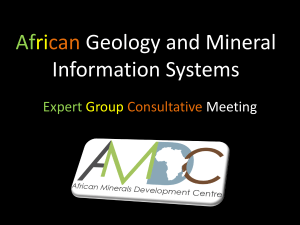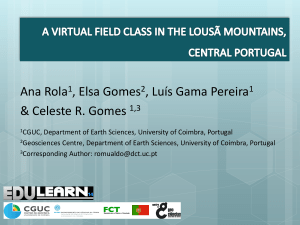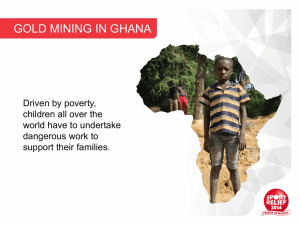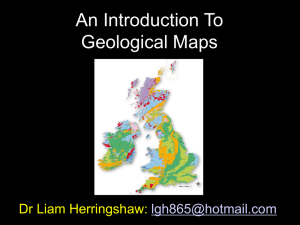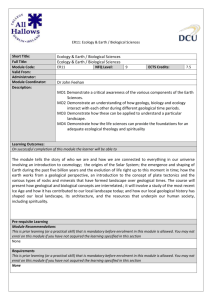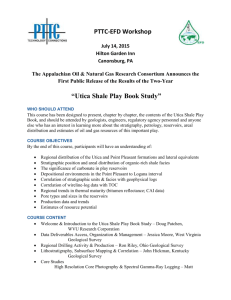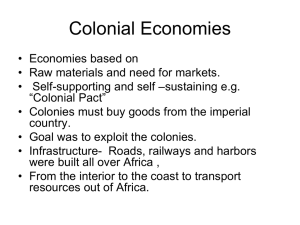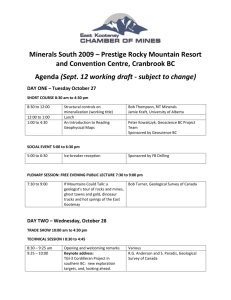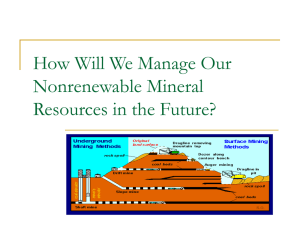MINERAL INVENTORY THROUGH EXPLORATION
advertisement
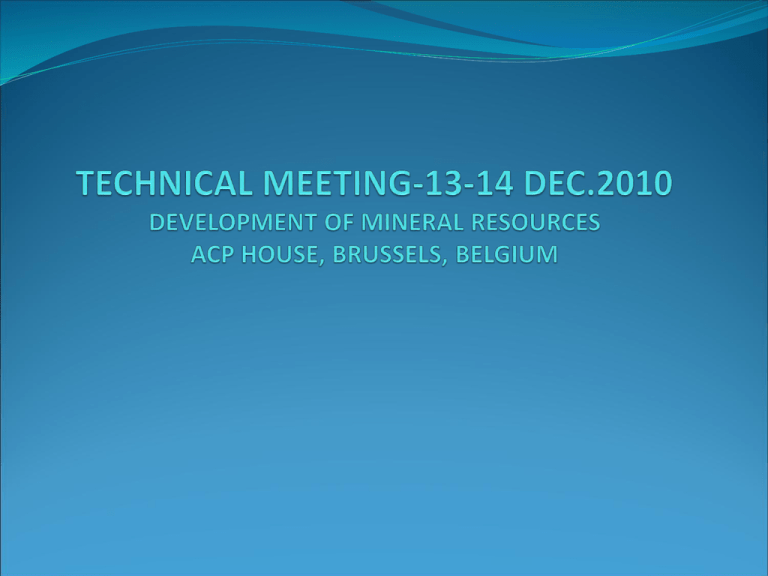
A Case Study In Ghana Yakubu Iddirisu CEO, Geological Management Consultancy Ltd(GEOMAN CONSULT.) The African, Caribbean and Pacific (ACP) states constitute a significant proportion of the global landscape – they account for approximately 19% of the earth’s surface area. The geology of the region is favourable and its largely unknown potential calls for a sustainable mining cooperation among member states. Nearly two-thirds of the ACP states are either mining countries or have a mining potential that if exploited rationally would contribute to their social and economic development. For instance mining in the subSaharan Africa excluding South Africa accounts for 8% of the world mining production. It generates almost 50% of the exports and 30% of the fiscal resources of the major mining countries. 80% of the surface area of this region has never been represented on any detailed geological map (of a scale of 1/200,000 or more) . Source: ACP Group Website The need therefore for the ACP countries to take inventory of their resources through exploration cannot be overemphasized. Mineral deposits in the ground are worthless unless they are explored and tapped for the economic development of their beneficiaries. In 2005 Ghana was a beneficiary of an European Funded reconnaissance exploration which covered 8 map sheets totaling 25,646 square kilometers. The project was under the Mining Sector Support Programme which lasted for 5years. It included Geological Data Provision which comprised two components: Geological investigation of eight 1:100,000 scale map sheets in selected parts of the country to produce geological data for investment promotion. The investigation comprised geological mapping, soil geochemistry and hydrocensuses. The Geological Investigation was undertaken by a Consortium comprising Council for Geoscience of South Africa (CGS), Bureau de Recherches Géologiques et Minières (BRGM) of France and Geological Management Consultancy Limited (GEOMAN) of Ghana. Showing 8 mapped field sheets An airborne geophysical survey of the entire Voltaian and Keta Basins was undertaken by Fugro Airborne Surveys (UK) with the British Geological Survey. The survey included the following: Satellite imaginary interpretation Magnetic and spectrometric surveys Gravity surveys and EM surveys Integrated Interpretation of Geological and Geophysical Data AREAS SURVEYED The GEOTEM regional survey included the area between the Volta River and Keta Basins. In addition to these regional surveys, Fugro Airborne Surveys conducted combined GEOTEM and magnetic surveys in eight detailed areas, of which six (A1-A6) are within the Voltaian Basin, one (A7) partly in the Keta Basin and one (A8) over the Winneba Belt (light red area and red polygon). Geotech Airborne Ltd. covered four areas with combined VTEM and magnetic measurements (light blue area and blue polygon). By Courtesy of GGSD Moreover, some mountainous areas outside the basins like Nkwanta were covered by helicopter-borne EM surveys undertaken by Geotech. The Terms Of Reference (TOR) for the mapping project were as follows Review all existing topographic and geological maps and publications concerning the map areas and their surroundings Acquire, process and interpret satellite imaginery to define structural and lithological groups Acquire and geologically interpret airborne geophysical maps Define a lithostratigraphic classification to be used during field mapping in accordance with Guidelines of the Sub-Commission for Stratigraphic Classification of IUGS Commission for stratigraphy Compile all mineral occurrences located within the map areas Compile data available on water boreholes (location, depth, water level and yield) Prepare a GIS map to reference the outcrops and structures identified above (synthesis map) Produce field base maps Methodology As has been pointed out earlier the investigation covered eight map sheets at a scale 1:100,000. Because of time constraint, it will not be possible to describe the work carried in each map sheet. Instead Nkwanta area would be used as the test case area. The study area is situated between Hohoe and Yendi with the eastern limits on the Ghana –Togo border. Map showing the location of Nkwanta map sheet Mapping Each field team generally comprised a consortium geologist and a trainee with a vehicle. Vehicles were used mainly for transportation between camp and field work areas and mapping was carried out mainly by foot. Intensive coverage with a regular grid of field observation and sampling was not possible due the pronounced relief and logistical difficulties. Several major traverses were carried out in the western range and towards the Togo range at an interval of 8kms. During the mapping process field outcrop coordinates were systematically acquired using a GPS and stored in a dataset. Samples were taken and used to make thin sections, for geochemical and geochronological analyses, and for magnetic susceptibility measurements. This picture depicts a typical rainforest terrain where mapping was undertaken An outcrop within the forest Sampling Due to difficult terrain in the Nkwanta area, a helicopter was used in gaining access to predetermined sampling points. In total 3344 samples were collected in the field at an average sample density of one sample per square kilometer. Sample position coordinates were saved at the sampling positions on GPS. This is the helicopter used to facilitate sampling in difficult areas South of Nkwanta Samples were screened out in Accra and Pretoria to<106um fractions. These size fractions were analysed for 28 elements: Ag, Al2O3, As, Au, Ba, Bi, CaO, Cd, Co, Cr, Cu, Fe2O3, K2O, MgO, Mn, Mo, Na2O, Ni, Pb, Sb, SiO2, Sr, Rb, ThO2, TiO2, U3O8, V and Zn. The helicopter lands at a pre-designed spot for a sample to be taken Hydrocensus Investigation The fieldwork consisted of geological mapping and hydrocensus of all existing boreholes. Water samples were collected and water levels, recovery and permeability tests conducted on the boreholes. Thereafter, all field data were compiled and coded according to their lithological units into a computerized data base from which a 1:100 000 scale hydrogeological map was produced. A hydrogeologist taking measurement in a borehole fitted with a hand pump Geology A simplified geological map of Eastern Ghana including Nkwanta map sheet area The area is underlain by upper Voltaian sediments along the western margin of the combined map sheet with the Togo metasediments along the eastern margin on the Ghana- Togo border. Sandwiched between these units is the Buem running N-S along the central parts of the mapped area. U-Pb analysis carried out on samples from the Buem yielded ages of 461±7Ma, a Variscan age. From a geochronological perspective, the Buem Group can no longer be associated with the Precambrian history of the Volta Basin. The evidence points to an Ordovician. A gossan was identified in the southwestern mapping area associated with ultra-mafics hosted in quartzites. EM Time Domain geophysical map showing concurrence with geology (courtesy of GSD) Mineral Potential In Nkwanta Map Sheet Old map indicating the occurrence of Fe only Current map indicating the occurrences of Ni Nickel anomalies mostly occur in the western portion of the Buem Group where they follow the same N-S trend defined by other elements including Fe, Mg, Cr, Cu and Ag. The prominent anomaly on the Ghana –Togo border is also repeated. High Ni probably delineates massive sulphide type deposits within the Buem Group and possibly ultramafic sequences in the Ghana -Togo border. Current map showing the distribution of Cu Copper: The most significant copper anomalies occur towards the western portion of the Buem Group and follow the same general trend as silver, cadmium and chromium. The Voltaian sediments seem to be devoid of anomalous copper. Current map showing the distribution of Mn Manganese: Most of the anomalous populations occur on the Buem Group where they define two prominent NS aligned zones in the southern parts of the map. Environmental implications, as far as deficiencies and toxicities of the elements in particular areas are concerned, are also addressed. A map showing areas that could be of concern is included. Conclusion The EU – funded regional mapping component of the MSSP at a scale of 1:100,000 has improved the status of geology and ensured a better understanding of the subject in the eight selected areas and in particular the Nkwanta Map Sheet. Geochronological dating as well revealed that the Buem group is younger than the Voltaian which has implications for mineral exploration. Nkwanta area that was only known to host iron and jasper deposits had interesting and far reaching outcomes which are presented as a lesson and a way forward for the future. The geochemistry mapping of soil data in particular allowed the identification of an apparent mineralized zones (metallogenic province) that may host specific types of mineralization. The provinces and anomalies that are of particular interest are those identified for Nickel, Cobalt, Copper, Zinc and Manganese. Recommendation Coming from Ghana’s experience it can be said without a doubt that a regional mapping program when properly executed associated with geochemistry and geophysics opens up new possibilities for the mineral exploration sector. What private Exploration and Mining companies need are good geological maps and indicators and these can be made available by carrying out: Systematic Regional Geological mapping of the country on a scale of 1:200 000 to 1:100 000 including dating of main units. Conducting a regional soil sampling programme Airborne regional geophysical surveys: (Magnetics, Radiometric and Electromagnetic methods) to provide information for the integrated interpretation of the field sheets and in helping Mining and Mineral Exploration companies in their target generation. Creation of good data bases and an Information Management System through which investors could have access to the data so generated. End THANK YOU
